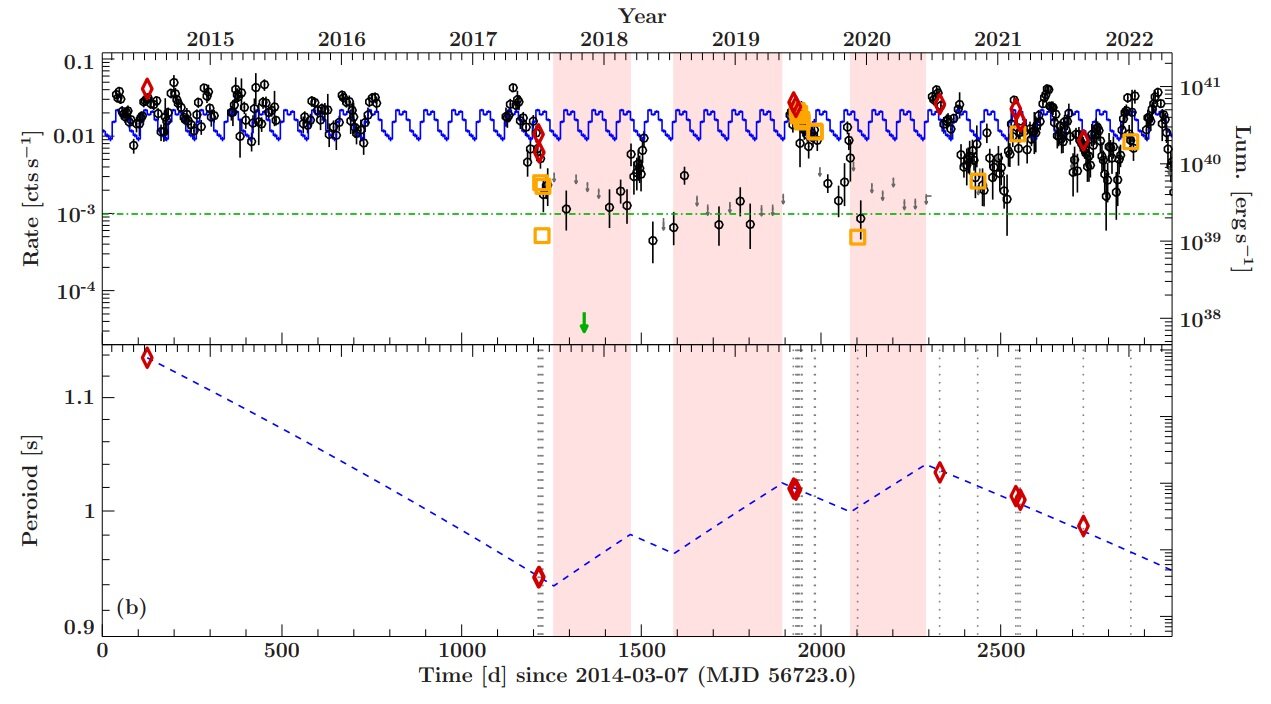#Study investigates magnetic field of an extremely ultraluminous X-ray pulsar

Table of Contents
“Study investigates magnetic field of an extremely ultraluminous X-ray pulsar”

Using NASA’s Swift spacecraft and ESA’s XMM-Newton satellite, astronomers have observed NGC 5907 ULX1—the most luminous ultra-luminous X-ray pulsar known to date. Results of the observational campaign, published February 7 on the pre-print server arXiv, shed more light on the magnetic field of this pulsar.
Ultra-luminous X-ray sources (ULXs) are point sources in the sky that are so bright in X-rays that each emits more radiation than 1 million suns emit at all wavelengths. Although they are less luminous than active galactic nuclei, they are more consistently luminous than any known stellar process.
Astronomers generally believe that due to their brightness, most ULXs are black holes. However, recent observations have found that some ULXs showcase coherent pulsations. These sources, known as ultra-luminous X-ray pulsars (ULXPs), are neutron stars typically less massive than black holes. The list of known ULPs is still relatively short; thus, studying objects of this class is essential for researchers exploring the universe in X-rays.
Reaching peak luminosity of about 100 duodecillion erg/s, NGC 5907 ULX1 is the most luminous ULXP so far detected. It is located some 56 million light years away in the Knife Edge Galaxy (also known as NGC 5907). NGC 5907 ULX1 has a spin period of approximately 1.14 seconds and is known for its fast spin-up during the on-state. However, still very little is known about the magnetic field of this pulsar as some studies suggest that it has a multipolar magnetic field with a strength reaching 100 trillion Gauss, while the others point to a magnetic field event 1,000 times weaker.
Therefore, in order to shed more light on the magnetic field of NGC 5907 ULX1, a team of astronomers led by Felix Fuerst of the European Space Astronomy Center (ESAC) in Madrid, Spain, has analyzed the Swift and XMM-Newton data from a long-term monitoring (between 2003 and 2022) of the pulsar’s X-ray flux and pulse period.
The study found that NGC 5907 ULX1 was in an off- or low-state between mid-2017 to mid-2020. During this off-state the secular spin-up trend reversed, and the neutron star rotational period slowed down significantly. After the off-state ended, spin-up resumed, however, at a lower rate than before.
The researchers employed different methods to estimate the magnetic field of the neutron star, either based on the spin-up or spin-down strength.
“The highest estimate for the magnetic field strength in our data is ≈ 2.5 × 1013 G, while for the low B-field solution, we find values as low as 2 × 1012 G. While based on these numbers we cannot distinguish which magnetic field is present in reality, we note that for a ∼1012 G field, we would expect to see a cyclotron resonant scattering feature (CRSF) around 12 keV, which so far has not been observed in the spectrum,” the authors of the paper explained.
The astronomers also estimated the magnetic field strength based on the spin-down during the off-state between 2017–2019 and found that it is at a level of 25 trillion Gauss. They noted that in general, all the results point toward the direction of a magnetic field with a strength of at least a few trillion Gauss in NGC 5907 ULX1. This indicates that the pulsar is accreting at very high rates.
F. Fuerst et al, Probing the nature of the low state in the extreme ultraluminous X-ray pulsar NGC 5907 ULX1, arXiv (2023). DOI: 10.48550/arxiv.2302.03425
© 2023 Science X Network
Citation:
Study investigates magnetic field of an extremely ultraluminous X-ray pulsar (2023, February 15)
retrieved 15 February 2023
from https://phys.org/news/2023-02-magnetic-field-extremely-ultraluminous-x-ray.html
This document is subject to copyright. Apart from any fair dealing for the purpose of private study or research, no
part may be reproduced without the written permission. The content is provided for information purposes only.
If you liked the article, do not forget to share it with your friends. Follow us on Google News too, click on the star and choose us from your favorites.
For forums sites go to Forum.BuradaBiliyorum.Com
If you want to read more Like this articles, you can visit our Science category.




